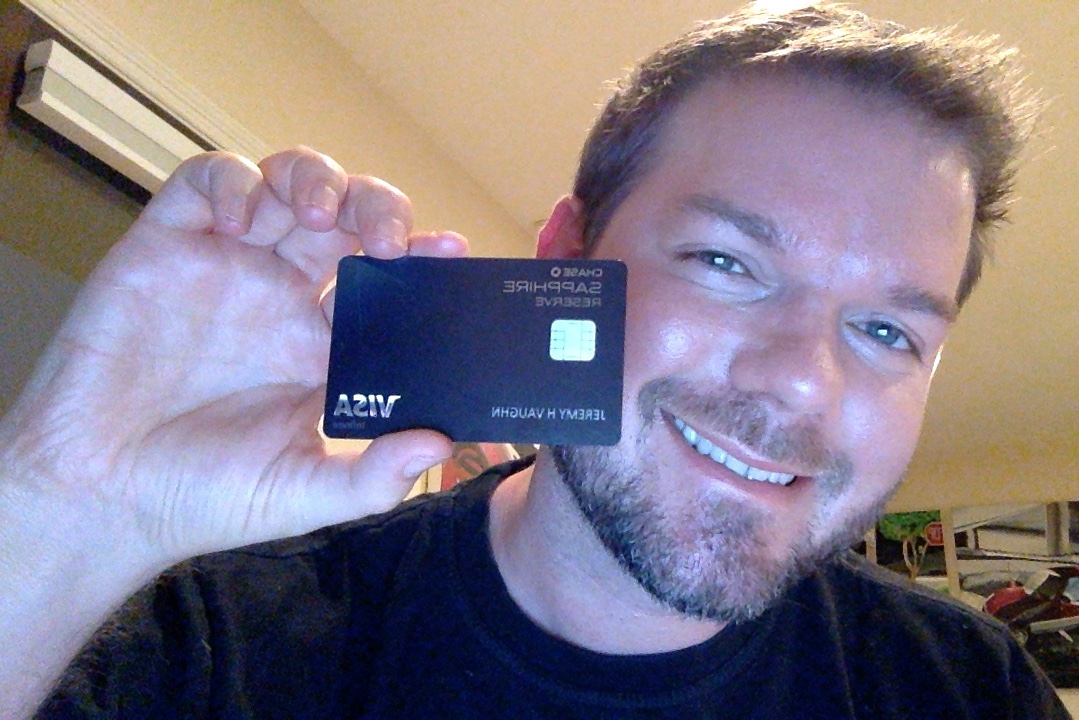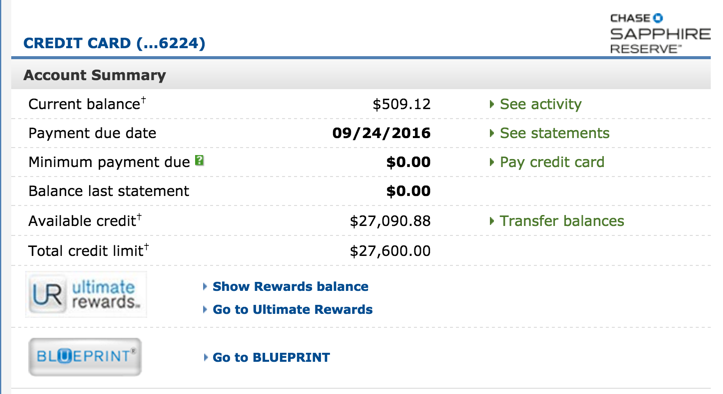I caved. And called Chase. Asked if they’d let me change my Chase Sapphire Preferred to the Chase Sapphire Reserve. And thankfully, they did.
I’m happy to report I’m now the owner of a shiny new Chase Sapphire Reserve card.

Got itttt
Here’s why I did it.
My Chase Sapphire Reserve Product Change
- Link: Honest Review: Chase Sapphire Reserve 100,000 Point Offer
- Link: Chase Sapphire Reserve – Compare it here
| Chase Sapphire Reserve® | 60,000 Chase Ultimate Rewards points |
|---|---|
 | • 3X Chase Ultimate Rewards points per $1 spent on travel & dining • 1X Chase Ultimate Rewards points per $1 spent on all other purchases |
| • $550 annual fee | • $4,000 on purchases in the first 3 months from account opening |
| • Why this is my favorite card for travel and dining | • Compare it here |
Like most of us, there’s no way in Hades I’ll ever be able to apply for this card with the current prohibitive 5/24 rule. I won’t fall under 5/24 until April 2017. So that means I’d have to wait ~7 months without applying for a single new card offer. Which ain’t gonna happen!
So I popped into a Chase branch and asked if I was pre-approved for, well, anything. NOPE.
OK, that’s cool. I asked if the pre-approvals refreshed at the beginning of each month, as I’d heard in my internet wanderings. The banker told me they refresh every 6 months. But couldn’t tell me where on the 6-month timeline I was. So at worst, that’s another 6 months of waiting. Grrrr.
I thought of that 100,00-point sign-up bonus. Man, it would burn to lose that.
But as I weighed the pros and cons, I decided to change my Sapphire Preferred to a Sapphire Reserve.
Why I did it
The 3X categories
All else being equal, I was losing out on earning 3X Chase Ultimate Rewards points for my travel and dining purchases.
Sure, I can earn 3X Citi ThankYou points on travel with the Citi ThankYou Premier. Between the two, I’d rather earn Ultimate Rewards points.
And I spend a lot on drinks dining, so 3X adds up quickly. I didn’t want to miss that.
$300 travel credit
I knew I could max that baby out and get $300 in essentially free Lyft rides, airfare, and NTTA tolls.
Then, after the close of my December statement, I’ll get another $300 to use. That erases the 1st year’s annual fee completely. And I even come out ahead. So that was also a huge draw.
The 1.5 rate is a comfort
Now, you can redeem each point for 1.5 cents toward travel when you book through Chase. That doesn’t mean you should, as the travel transfer partners are way more valuable. But I like knowing that no matter what, my points will always be worth a certain baseline.
This is admittedly more psychological than anything – I like how Chase is besting Citi, in particular. Hopefully this type of competition nudges Citi and Amex toward improvements in their own cards with big annual fees. As I always say, when banks compete – you win.
I’m NOT giving up opportunities
Waiting 6 or 7 months without a new card to fall below 5/24 is something I’m not willing to do. Even for 100,000 Chase Ultimate Rewards points.
At a base level, those points are worth $1,500, which is awesome.
Add to that rumors of a new premium Amex card, and the inevitable limited-time offers that will pop up over the next 6 or 7 months and I think: do I really want to miss out on all that?
I routinely get 200,000+ points per app-o-rama. And I just got a new Amex Hilton card for another injection of 75,000 Hilton points.
If I was say, 3 or 4 months away from 5/24, I’d think on it. But 6 or 7? No way.
100,000 Chase Ultimate Rewards points is a lot, and worth a lot, but so are the other cards I apply for and open regularly.
And in the end, I’d rather have access to the 3X categories and annual $300 travel credit than not.
My experience product changing
First, I applied for the Chase Sapphire Reserve online, like a buffoon. When the app when to pending, I wasn’t surprised. I eventually got the rejection letter saying “too many open cards in the past 24 months” – a blatant admission the 5/24 rule exists.
So then I called Chase at the number on the back of my Sapphire Preferred card, and was transferred to a credit analyst.
Before I asked to switch, I asked once more if there was any way to be reconsidered. He said, “Sorry, my hands are tied here. There’s nothing we can do.” (Which I expected.)
Well OK, then. I still want it. Can I change my Preferred to a Reserve and move some credit to the new card, too?
No problemo.

Just like that, it was done
As soon as I logged out and back in again, it was there.
He said I could continue to use my Sapphire Preferred in the meantime – it would earn 3X in the bonus categories and the $300 travel credit was active immediately. That was really cool. I wasn’t sure if it would work that way, but it did.
A few days later, I received a UPS envelope with my shiny new (metal, not plastic!) Chase Sapphire Reserve card inside.
I gotta say, I still felt giddy about getting the card, even though I knew there would be no big sign-up bonus for me.
Oh, I should mention! I recently paid the $95 annual fee on the Preferred. It was pro-rated when I closed the account. And the $550 will appear on my next statement. So I didn’t lose anything by switching.
A small ray of hope
But before I hung up with the Chase analyst, I asked a very explicitly worded question:
“If I were to qualify for a new Chase card, could I product change the Reserve back to the Preferred, then apply for the Reserve, and earn the sign-up bonus on it?”
He knew exactly what I meant. “Yes,” he said. “That would work.”
So if you want to go that route – get the card, max out the travel credits, then change it back again until you can fall below 5/24, it seems that option exists. Sort of like a buy now, pay later dealio.
I’m still on the fence about actually doing this. As mentioned before, 6 or 7 months is just too long to wait for me. But it may be worth it to you.
Bottom line
- Link: Chase Sapphire Reserve – Compare it here
The Sapphire Reserve’s $550 annual fee comes to net $250 after the $300 travel credit is considered.
For the 3X category bonus and access to 1.5 rate for travel booked through Chase alone – it’s worth product changing. And it’s interesting how Chase deliberately cannibalized their own Sapphire Preferred product. Why would anyone keep or go for the Preferred at this point, other than the lower – on paper – annual fee is beyond me.
If you can’t wait to fall under 5/24 and want the card right away, you can product change to it and enjoy the benefits until you do. At which point, you’d product change it to something else (maybe the Chase Freedom Unlimited?) and then apply for a new Sapphire Reserve account. So that could be a nice workaround to access the 3X categories and $300 annual travel credit before 2016 is through.
The process couldn’t have been easier. A 10-minute call with some light begging for reconsideration at the beginning, and it was done.
If you have the Sapphire Preferred, there’s no reason to not product change to the Sapphire Reserve.
Will you change any of your Chase cards to the Sapphire Reserve, or have you already? Did you have a similar reasoning?
* If you liked this post, consider signing up to receive free blog posts in an RSS reader and you’ll never miss an update!Earn easy shopping rewards with Capital One Shopping—just log in and click a link.
Announcing Points Hub—Points, miles, and travel rewards community. Join for just $9/month or $99/year.
BEST Current Credit Card Deals
The responses below are not provided or commissioned by the bank advertiser. Responses have not been reviewed, approved or otherwise endorsed by the bank advertiser. It is not the bank advertiser's responsibility to ensure all posts and/or questions are answered.


That $4K in 3 months requirement is pretty hefty, but perfectly timed for me – my pool needs to be resurfaced rather desperately. That costs $4500 and starts tomorrow 😀 But, I also have Ink and Freedom, so I was immediately able to transfer and use existing points to book travel at 1.5 cents per mile, which I totally did asap.
Yay for meeting the spending on something you needed anyway – best way to do it!
I am loving this card so far. I wish it had the travel protection of Citi Prestige (and of course I wish I could earn the bonus), but I’m funneling more of my spend into Chase now because of it. Good job staying top-of-wallet, Chase!
I know the $450 AF sounds big, but if you spend $300 on travel in a year, it’s so beyond worth it.
And you have the right idea with combining the points – love it!
Harlan,
After receiving the $300 annual travel credit on your Chase Sapphire Reserve card, do you spend at least $6000 annually in dining/travel to equal or exceed the 2% return on a Citibank Double Cash card or $10,000 annually in dining/travel to equal or exceed the 3% return on the Citibank Costco card? I do not count the Costco membership fee against the 3% return since I will pay it anyway. When I look at airline point redemptions using the Chase Sapphire Reserve, I struggle to achieve point redemptions rates above 1.5 cents per point without premium airline seating. All the CSR benefits are nice, but I struggle with making the point redemption calculations beat cash back options. Any insights would be appreciated.
Here’s how I view the 3X categories: I like to transfer the points to travel partners, and I have a rule that I always get at least 2 cents per point in value. Period.
So 3 points x 2 cents each is worth 6 cents, or a 6% return on travel and dining. Even at the 1.5 cent per point level, 3 x 1.5 is a 4.5% return – both are better than 2% or 3% back.
If you’re factoring in the the annual fee, do I spend $6K a year on travel and dining AKA $500 per month? Absolutely. One flight and eating out a couple of times easily gets me there.
Even at the 1X level, you can achieve a 2% return on non-bonused spending with the CSR. But some peeps prefer to earn cashback instead of points. If you want to earn points for travel, it’s hard to top this card. But if you want to earn cashback, a 2% or 3% cashback card can be an asset.
Also note with the Citi Costco Visa, you must redeem your reward once per year toward Costco merchandise. And if you cancel your membership for any reason, you lose it all. I prefer to get rewards monthly so that when I reach a certain level, I can redeem them toward a travel goal.
What do you make of that? I love how everyone personalizes their cards and spending so I’d appreciate your insights, too.
And thanks very much for the question, and for reading!
Ok. How do I consistently get 2 cents per point with transfers to Ultimate Rewards travel partners? It seems that I get about 1.2 to 1.5 cents per points with typical redemptions I research. I would be all in with the CSR at consistent 2 cents per point redemptions.
Well, with CSR you have no reason to ever fall below 1.5 cents per point, for starters.
With travel partners, you just run the numbers each time. I’ve gotten fast about it.
For example, most round-trip coach flights are 25K miles. So if it’s under $500, not worth using miles for. 25,000 x .02 = $500.
Say you want to take a short, expensive AA flight. That could be 7,500 Avios (transfer to British Airways). 7,500 x .02 = $150. If it’s more than that, you are over 2 cents per point = a good deal.
The best way to consistently get that return is to familiarize yourself with the sweet spots of each program and repeat the math every time. If you come up with anything below 2 cents per point, just buy it.
If you don’t think you’ll get this consistently because of your travel patters, then you’re right – a 2% cashback card is a better choice.
Even still, if you spend a lot in the 3X categories, you still get 4.5% back (3 x 1.5), and that would still make this card a keeper, IMO.
Did you get the card in a plain white envelope or inside of the box with all of the paperwork and benefits guide?
Plain white envelope
I wrote that comment on mobile and added a crying face emoji at the end that didn’t make it through. I say that because I kinda wanted the “unboxing” experience but was given the plain white envelope instead. Ah, well. I’m just happy to have it, either way.
They did include a slim benefits guide in there, though.
This card is an awesome addition to the Chase family of cards. Let me compare here the overall value difference between the Chase Sapphire Reserve (CSR) and Chase Sapphire Preferred (CSP). I will take my own spending analysis as an example. I am not a huge traveler, I travel once in a while with family or buy tickets to my parents to travel. I sat down to do the Math to see if it makes sense for me to apply for this card (I already have CSP card). Let me admit the fact that I also have Chase Freedom and Freedom Unlimited cards and my wife and I know which card to use when to earn maximum Ultimate Reward (UR) Points.
Let’s look at my spending closely. The first thing I analyzed was my expenditure over the past 4 years (I referred to year-end summaries) and I found that I have consistently spent around $350 on “Transit” which included- Parking (street and occasional airport), E-Z Pass tolls, occasional river cruise, occasional Uber etc which I am sure will do every year. So this pattern of my spending qualifies for the $300 “Travel Credit”. This takes away around 65% of $450 annual fee that the CSR has. Needless to say that the person reading this is ready to use the UR points ONLY FOR travel.
Then I looked at the UR Points that I earn from my Freedom and Freedom Unlimited card. In the worst case scenario every year I earn 175K from Freedom (We religiously use this card only for 5% cash back categories only and nothing else) and 220K from Unlimited card (I use it for all other expenditure other than Travel and Dining for which I used CSP).
Let me break it down further to see if it makes sense for me to apply for CSR card with my low travel spending. Let me assume that I have CSR card with me for the next 1 year. I spend around $2300 on dining outside which will earn 6900 UR Points with CSR card and even if I spend around $350 bare minimum on travel it will earn me 1050 UR points (this is the worst case scenario). Once I add this up it gives me a total of 47400 UR Points ($474). If I use this for my occasional Travel via Chase Portal the value is up by 1.5 times which is $474 X 1.5 = $711. Let’s take away the remaining annual fee out of this ($711-$150) which gives us the net gain of $561 which is awesome!! Let me add my wife as an authorized user so the net will go down to $ 486 ($75 annual fee for an authorized user) which is nothing less than awesome and even in the worst of the worst case scenario where you do not even qualify for $1 of Travel Credit in one of those years (extremely unlikely) you will not spend anything out of pocket. Happy?? 🙂
Now let’s do the same math with one of my favorites Chase Sapphire Preferred. If you do the math as above with 2 points earning per $ spent on travel and dining I would have earned 4600 UR points for dining outside and 700 UR points on travel. Let’s put everything together, which gives me $448 ( $220+ $175+ $46+ $7). Now let’s redeem this for travel, remember Chase Sapphire Preferred gives is 1.2 times more value. So $448 X 1.2= $537. Now let’s look at the net value by taking away the annual fee of $95 which gives me $446. This card does not charge for authorized user.
Conclusion: There is no question that Reserve card has superior benefits compared to Preferred. Here I conclude that for anyone like me who does not travel much at all and have Freedom and Freedom Unlimited cards (both earn UR Points) the overall net benefit is more with $450 annual fee CSR card when compared to lower fee CSP card (Please see the math above).
Now guys! Do the Math and check if you could have CSR instead of CSP without spending even a $ more. Don’t be scared or discouraged by $450 annual fee. Of course needless to say that if you don’t travel much, you need to have both Freedom and Freedom Unlimited cards and know when to use which of these 3 cards. All you need is these 3 cards!!
Good luck! Keep rocking!
Wow, thanks for this thorough analysis! Keep rocking indeed! 🙂
Thank you for the platform! Any idea when chase is sending us the metal cards? I have plastic card now.
No idea. I’d guess a few more weeks.
You’ve really only opened 4 accounts (not counting non-Chase business cards) in the last 17 months? That was by far the most amazing item in this post!
If that’s the case, unless all 4 were Amex Platinum 100k cards, not sure how you’re figuring you’d be missing out on lots of bonus points by waiting? You can still sign up for new business accounts from other banks, since 5/24 ignores hard pulls.
I get that you can now have the card WHILE waiting out the 7 months, but this whole column was written with assuming the only option was waiting the 7 months.
That’s true, but I don’t want to limit myself to just business cards. The opportunity cost is just too great.
Terrific point though – and a great option for peeps who are willing or want to wait to fall below 5/24 – thanks for the reminder!
Hey, Harlan! Do your credit reports reflect the date the account was originally opened or the date you product changed? I’m considering doing this with Freedom, but it’s now my oldest card, so I’d prefer to hold on to that longevity. Thanks much!
Yes! I’ve product changed twice with Chase now. My Freedom is from 2002 – I changed to it from a Slate card.
No change for my Sapphire open date, either on my report!
Beautiful. You rock! (Duh)
🙂
I would also add that you need to hold the preferred card for a minimum of 1 year in order to do this. I didn’t see any discussion about this here.
I knew they had to review each account before a product change. Thanks for adding this!
My understanding is that Citi allows PC after 11 months of the first year of a card.
Could you delete my comment as my brain clearly wasn’t working. Somehow I heard Preferred and was thinking Thank You Preferred , forgetting the actual topic here!